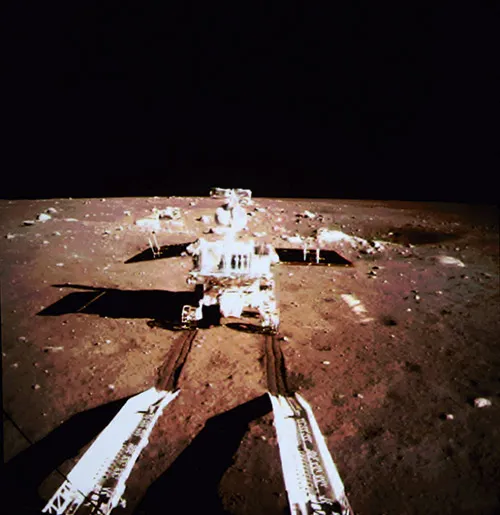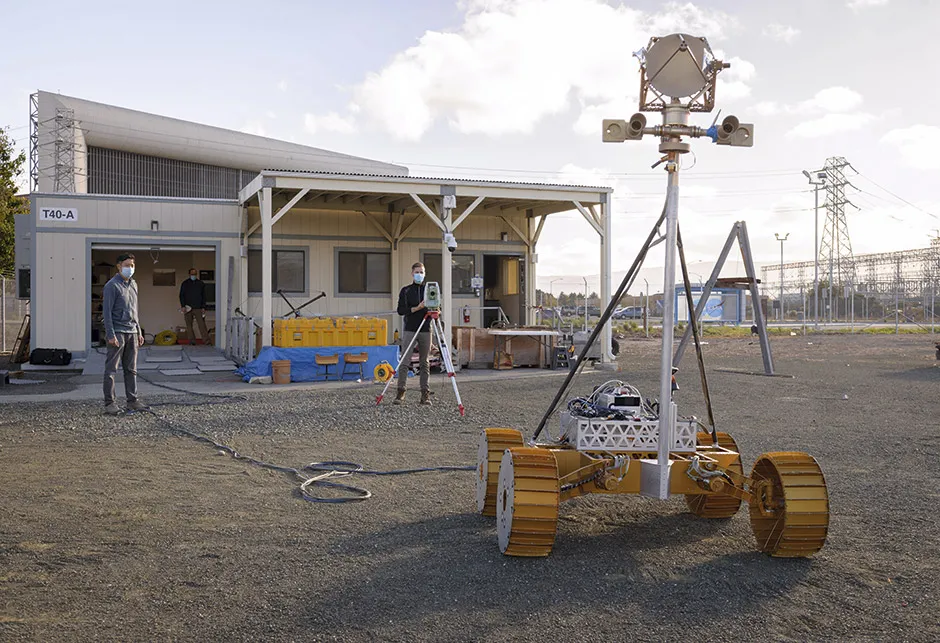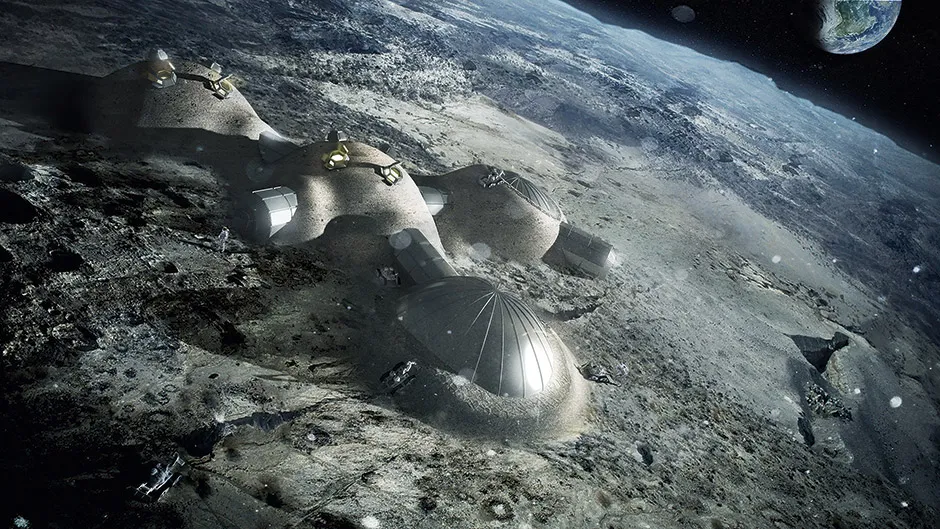For almost 40 years, our nearest cosmic neighbour, the Moon, was left alone as we looked elsewhere in the Solar System. That changed in 2013, when China’s Chang’e 3 lander touched down on the lunar surface. Since then there’s been an explosion of interest in the Moon. NASA, China and even private companies are racing back to it, with dozens of robotic and human missions being planned. Things are set to get a lot more crowded on the lunar surface over the coming decade, but this time, we’ll be staying.
“We know the Moon has potential resources that will be useful for space exploration,” says Ian Crawford, a professor in planetary science from Birkbeck, University of London. “Particularly water ice trapped in the very dark shadows of craters at the poles.”
Unlike Earth, the Moon’s axis isn’t tilted at a large angle, so the Sun is constantly overhead when you’re at the lunar equator. If you’re at the lunar poles however, the Sun’s always on the horizon, creating long, permanent shadows in the surrounding craters. Hidden from the Sun for billions of years, temperatures in those craters are low enough that water ice has been able to survive in them and it’s this that’s captured everyone’s interest.
“Water is an extremely useful substance for space exploration, certainly in the context of human exploration,” says Crawford. “It’s a requirement for life, but can also be broken down into oxygen and hydrogen. Combined, they’re a useful rocket propellant.”

Though planetary geologists have seen signs of lunar ice for years, the first definitive proof of the presence of water came in 2018, following detailed analysis by NASA’s Moon Mineralogy Mapper on the Indian lunar orbiter Chandrayaan-1.
While we have plenty of water here on Earth, it’s heavy – each cubic metre weighs 1,000kg. Launching it into space takes a huge amount of energy. If, instead, we could find a way to harvest water beyond Earth’s gravitational pull, it would allow for bigger and more ambitious projects, both on the Moon and beyond.
“If we’re going to engage in a programme of human space exploration, the Moon is the obvious place to start,” says Crawford.
While there appears to be water at both poles, it’s most concentrated in the south. A region known as the South Pole-Aitken Basin – the Moon’s largest impact crater – is home to several large deposits of ice. What’s not clear, however, is what form the ice takes.
“We’re still in the initial prospecting phase,” says Crawford. “We don’t know whether we should be investigating big blocks of ice here and there, or just tiny, micron-sized grains of ice mixed in with the lunar soil.”
Read more about exploring the Moon:
- Race to the Moon: Inside China's plans to build a lunar base
- Lunar Orbital Platform-Gateway: The next space station will orbit the Moon
NASA is planning a mission to send the Volatiles Investigating Polar Exploration Rover (VIPER) to the Aitken Basin in 2023. Once there, it will drive into the shadow of one of the craters to investigate the ice on the surface and, with its drill, two metres below it.
The water is also of particular interest to scientists. As it has remained undisturbed for millions, or sometimes billions, of years, it gives planetary geologists a window into the past.
“The Moon is very ancient and geologically inactive, which means that it’s sort of a museum to the evolution of rocky planets – [its rocks hold] a record of its earliest evolution from shortly after its formation,” says Crawford. The ice could act as an archive, detailing how water was brought to the Moon by comets and asteroids. As these would have also carried water to our planet, such an understanding would tell us as much about the history of Earth as it does the Moon.

While many missions would like to follow the water and explore the polar regions, this isn’t without its challenges. Until now, most lunar missions have touched down around the sunlit equator where solar panels can easily supply power. It’s much trickier when you’re heading somewhere that’s in permanent darkness.
Some early missions, such as VIPER, will use rechargeable batteries to undertake brief sojourns into the shadows, but longer-term missions will require more thought. If future astronauts plan on mining the lunar ice, they’ll need a permanent base to do so and that will require a very specific location to prosper.
“The best place, if you could find it on the Moon, would be a permanently shadowed area with water, near a peak with persistent light that could stay sunlit almost all year for powerfrom solar panels, and a cave for shelter,” says John Thornton from Astrobotic, the company contracted by NASA to transport VIPER to the Moon. “Caves provide a nice, thermal environment underground. If we could find that location, there’s no doubt that’s going to be the place where a human settlement pops-up.”
Once a spot is found, it then becomes a case of building a base. Initially, this will probably be done with structures transported from Earth, though weight and size restrictions on launch vehicles will limit what can be sent, so it would be much better to build a base in situ. Fortunately, there are building materials everywhere on the Moon. Several projects are looking at harvesting regolith – the fine layer of dust created by micrometeorites pulverising lunar rocks – and using it to 3D print structures.
In the longer term, it could be possible to extract iron and titanium from lunar rocks. We’d need to build a refinery to process them, but having access to such metals beyond Earth’s gravity would allow us to build much larger structures and spacecraft. The Clementine spacecraft, launched in January 1994, detected the highest levels of the metals around the lunar mare – the dark regions created by ancient lava flows. As an added bonus, most of the ores are oxides, so they’d produce oxygen as a by-product.
But not all potential lunar resources are as easy to extract. There are an estimated billion tonnes of helium-3, a potential fuel source, on the lunar surface, but extracting it would require a huge industrial complex mining hundreds of tonnes of regolith every second – a prospect that’s centuries away from being feasible, even under the most ambitious circumstances.

Such ambitious plans can’t be undertaken alone, however. Currently there are two superpowers working to put humans on the Moon: the US and China. Though US law prevents the two from collaborating, they’re both reaching out to other nations to help them achieve their goal.
“Lunar exploration can become a tremendous focus for international cooperation, which I think would be highly desirable, especially in today’s international climate,” says Crawford.
Despite having only sent its first ‘taikonaut’ into space in 2003, China’s space programme is making great strides. Its Chang’e series of robotic lunar missions has been wildly successful and saw the first landing on the far side of the Moon in 2019 (Chang’e 4) and plans to return the first samples from the lunar south pole with Chang’e 6 (due to launch in 2023).
The Chang’e 4 mission carried instruments from the Netherlands, Sweden and Germany, while European astronauts have already run several training exercises alongside their Chinese counterparts. Though the Chinese are secretive about their precise plans, they’ve made it clear that these missions are a precursor to a lunar landing mission.
With several decades more experience to call upon, the US efforts are a little more mature. Their current plans are centred around the Gateway, a lunar station that would orbit the Moon. The station would act as a staging post for missions to the lunar surface, and potentially Mars and beyond.
The Japanese, Canadian and European space agencies have all signed up to help, agreeing to build parts of the station on the promise of one day sending their own astronauts to the Moon. The first sections of the Gateway are due to fly in 2023, with operations starting in 2026. Meanwhile NASA is already planning the Artemis mission, which will send the first woman to the lunar surface by 2024.

These ambitions are also helping to foster a branch of space exploration that’s blossomed over the last decade: private enterprise. To encourage the growth of the space sector, NASA set up the Commercial Lunar Payload Services initiative, asking companies to transport the space agency’s science instruments to the Moon.
“NASA has plans to buy at least two lunar missions per year for the next eight to 10 years,” says Thornton. “This is a first step towards commercialisation of routine, regular transport to the Moon.”
As well as being much cheaper for NASA, it also creates opportunities for those with a much smaller budget. In late 2021, Astrobotic will be sending its Peregrine lander to the Moon with a dozen NASA instruments, but it also has room to transport other projects at the cost of $1.2m per kilo (approx £850,000). That might sound a lot, but in spaceflight terms it’s a bargain.
“We have a broad array of customers, even just on our first mission,” says Thornton, who has seen universities, companies and even private individuals sign up to hitch a ride. “We have a payload from the UK that’s actually a fun little walking rover that’s going to walk across the surface.”
Alongside Astrobotic are many other companies all preparing to head to the lunar surface. Though none of them has successfully landed yet, there’s no shortage of passengers waiting to hitch a ride. The lunar surface is about to get busier than it’s ever been.
- This article first appeared inissue 362ofBBC Science Focus Magazine–find out how to subscribe here
Read more about the future of exploration:
